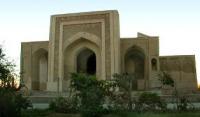Вы здесь
Namazgoh mosque.

Excursion on mosques of Bukhara.
“That was the day the ancient songs of blood and war spilled from a hole in the sky
And there was a long moment as we listened and fell silent in our grief and then one by one, we stood tall and came together and began to sing of life and love and all that is good and true
And I will never forget that day when the ancient songs died because there was no one in the world to sing them”
Brian Andreas.
Method of travel in Bukhara.
The Namazgah or Namazgoh mosque of Bukhara, is an open air place with a monumental mihrab used for congregational prayers during important religious festivals.
Known as musalla or festival mosques, namazgahs are open-air mosques capable of accommodating large crowds or camping armies and were often built outside cities, or along major roads.
Bukhara's namazgah stands amidst orchards, to the south of the shahristan or the city proper. It is one of Bukhara's oldest surviving structures, and is contemporary to the celebrated Poi Kalan Minaret.
Originally constructed in 1119 under Qarakhanid ruler Alp Arslan Khan Mukhammad, the namazgah was significantly modified in three subsequent stages. The first stage, dating to the XII century is a baked brick qibla wall, approximately 38 meters long.
It consists of a central mihrab niche flanked by a blind arch on either side. The broad forecourt is thought to have been partially fenced in, to demarcate sacred territory.
The space immediately in front of the mihrab may have been roofed, as seen in similar structures in Merv and Nissa.
The second stage consisted of the addition of geometric brick and terracotta decoration during the 13th century under Mongol Il-Khanid rulers. Timurid reign in the XV century added decorative bands made of glazed tile.
Astrakhanid rulers in the XVII century commissioned the final and the most extensive modifications. A new façade with a three-bay portico, centered about a pishtaq or a projecting portal was attached to the original qibla wall, raised on a stone plinth.
A brick minbar perhaps replacing a wooden predecessor was added to the northern corner of the portico facing the congregation. The namazgah's front elevation presents a horizontal skyline, with the central pishtaq screening the high central hemispherical dome.
The adjacent secondary cells are vaulted and do not interrupt the dominant horizontal emphasis. The rear elevation presents a stepped buttress wall, reinforced by two cylindrical abutments.
There is an octagonal hauz, or stepped lake made of hewn stone, to the north east of the qibla that was possibly used for ablutions. The namazgah is made of baked brick, terracotta and ganch, or alabaster panels, resulting in a predominantly monochromatic ochre composition.
The incised terracotta panels, especially in the interior, bear traces of polychromatic decoration. The pishtaq is lined with blue ceramic bands with kufic calligraphy. Its tympanum is filled with interlocking stars stars and hexagons in blue ceramic.
The structure exhibits extensive damage to its plinth and roof, caused by water seepage. Its relative remoteness to major tourist sites has resulted in its disuse and neglect.
Authority:
Azizkhodjayev, Alisher. 1997. Bukhara: An Oriental Gem. Tashkent: Chief Editorial Office of Publishing & Printing, 43, 50, 84. Borodina, Iraida. 1987. Central Asia. Gems of 9th-19th Century Architecture. Moscow: Planeta Publishers, 25, 119. Michell, George. 1978. Architecture of the Islamic World. London: Thames & Hudson, 260. Prochazka, Amjad Bohumil. 1993. Bukhara: Architecture of the Islamic Cultural Sphere. Zurich: MARP, 95.







